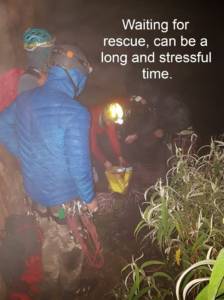This week, I will run a series of what happens when things go badly wrong and how you should handle it. These are skills and knowledge that you are unlikely to ever hear on a First Aid course and, which I have learned from 3 decades of dealing with mountain rescues and having handled several emergencies myself in the mountains. From a broken ankle to the death of a friend, an asthma attack of a client, to a Puff adder bite to my own leg.
These posts are an extract from the Mountain Leader and Walking Group Leader courses I run, but they would equally apply to a rock climbing or mountaineering situation.
First we are going to look at a few aspects that are vital in handling emergencies in the mountains or any other wilderness type situation in southern Africa. By wilderness, I would however, not include a game reserve situation where dangerous animals could be involved.
Part 1. As a leader of a party what should you do.
Part 2. Dealing with an emergency situation. (Not the First Aid aspect)
Part 3. If a helicopter is being used, know what it can do and more on what it CAN’T do.
Part 4. How to search for a missing person and what goes on when a search is escalated.
Part 5. Improvised patient carrying methods.
As a leader of a mountain group…..
When an emergency occurs, it is obviously going to be a difficult time for everyone and in particular, the leader of the group will often carry the brunt of the stress. Firstly, it is important to remember that very often, what seems terrible at first, can start to be seen more clearly after a short time of thought and analysis of the actual situation. That means you need to force yourself to understand what the actual situation is.
Let us use an example of someone falling and breaking their leg. In those first few minutes, everyone is shouting and wanting to know what to do, and are trying to help. The victim is also probably screaming. But just try to calm things down. Get the victim into a comfortable position and away from any danger. The next step is going to sound a little callus but needs to be understood. The patient will be in terrible pain, shock, or trauma, but unless a major artery has been cut, they are not likely to die anytime soon. That means there is time to sit and think about how this situation needs to be handled and including applying First Aid to the best of your ability. Once that is done, work out which rescue service to phone and what is appropriate to where you are situated. (There are different numbers and rescue structures in different areas of South Africa. Every person venturing out in the wilderness should have an idea of the local rescue structure for that area.)
All this will take good leadership and a calm attitude. A calm plan needs to be worked out. People can be given different tasks. E.g. Someone can make a cup of tea, another can act as a message runner in-between the patient’s location and cell phone coverage area.
A few DON’TS. Once it has been established what to do and who to phone for help, make the call. Once the call is through to the correct source, the group has to sit down and realise the wheels of rescue are now in motion. DON’T then phone more rescue agencies, as it can create confusion and a muddle up of resources and communications!
DON’T allow members of the group to phone out informing family and friends, who then also start to phone for rescue to all kinds of inappropriate agencies. These situations cause huge issues for rescue teams and helicopter co-ordination.
DON’T move away from the place where you told a rescue team the incident has occurred.
DON’T call for help straight away. Get to grips with what the real situation is first. When all is calm, start to ask for help.
On Table Mountain in Cape Town, an emergency can be dealt with quickly due to the short physical distance between the mountain and the rescue services. But just by the very nature of mountain hiking and climbing, emergencies are often far away from help. In most cases a group sitting with an injured friend is going to wait a long time! Many hours sometimes pass before help arrives. It may even mean spending a night out looking after a person. Try to make yourself and the patient as comfortable as possible, as it is going to be a long stressful time.
Tomorrow in Part Two, we look at a similar area of dealing with a patient.
